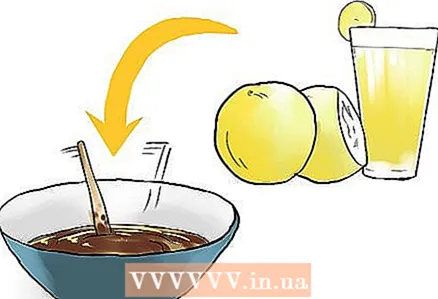Author:
Carl Weaver
Date Of Creation:
28 February 2021
Update Date:
1 July 2024

Content
This article will allow you to make your own high-quality and safe paint for creating drawings on the skin. If you can bake a cake from a ready-made mixture, you can make your own henna for coloring.
Steps
 1 Place 20 grams (1/4 cup) of good quality henna powder in a bowl.
1 Place 20 grams (1/4 cup) of good quality henna powder in a bowl. 2 Add lemon juice little by little. Stir until the resulting mixture resembles mashed potatoes in consistency (you need to add 30-60 milliliters of lemon juice).
2 Add lemon juice little by little. Stir until the resulting mixture resembles mashed potatoes in consistency (you need to add 30-60 milliliters of lemon juice).  3 Cover the bowl tightly with cling film and leave in a warm (but not hot) place for 12 hours.
3 Cover the bowl tightly with cling film and leave in a warm (but not hot) place for 12 hours. 4 Remove the film and add one and a half to two teaspoons of sugar.
4 Remove the film and add one and a half to two teaspoons of sugar. 5 Add one to one and a half teaspoons of aroma oil (tea tree or lavender oil, or a mixture of both works well).
5 Add one to one and a half teaspoons of aroma oil (tea tree or lavender oil, or a mixture of both works well). 6 Stir well, cover again with plastic foil and leave for another 8-12 hours.
6 Stir well, cover again with plastic foil and leave for another 8-12 hours. 7 Remove the foil, stir and add lemon juice until the mixture reaches the consistency of liquid yogurt (the mixture should slowly drain from the spoon into the bowl).
7 Remove the foil, stir and add lemon juice until the mixture reaches the consistency of liquid yogurt (the mixture should slowly drain from the spoon into the bowl). 8 Place the resulting henna in containers that you will use for staining (plastic cones, special plastic bottles with a narrow tip, etc.)and freeze until you use them.
8 Place the resulting henna in containers that you will use for staining (plastic cones, special plastic bottles with a narrow tip, etc.)and freeze until you use them.
Tips
- Henna can be stored for a long time. Store henna powder and prepared paste in the freezer if you are not using them right away.
- The longer you leave the applied henna on the skin, the darker the result will be. You should leave the paint at least. for 4 hours, but it is better if the paint will act on the skin for at least 8 hours.
- Make sure you buy henna for skin painting, not hair coloring.
- If you live in a very dry or very humid climate, you will need to decrease or increase the amount of sugar in the coloring paste. Sugar helps the paste to stick better to the skin.
- Leave a small amount of dry henna powder in case your paste is too runny.
- Buy henna powder from a trusted retailer who knows how to store it properly. You will not be able to tell by eye how fresh henna you buy, some sellers add other crushed plants to henna to make the powder greener and make customers think that henna is fresh.
Warnings
- If you have made a henna pattern on your skin, remember that it breaks down at high temperatures. Optimal weather conditions are 20-25 degrees Celsius.
- Henna is not black! Any product that says it is suitable for making black patterns that remain on the skin for more than two weeks contains finelandiamines, which can seriously damage your skin. On this site you will find more information on this: www.hennapage.com/henna/ppd/index.html
- Use only quality scented oils that are safe to use on the skin.
- Do not put mustard oil over the pattern or add clove oil to the paste. These oils cause severe irritation to the skin and mucous membranes.
- Do not use lemon juice if you are allergic to citrus fruits. Strong black tea (cold) or even Coca-Cola and Pepsi-Cola can replace lemon juice (note that the caffeine in these drinks can penetrate the skin, so do not use these drinks if you are sensitive to caffeine) ...
- Do not use henna if you have G6FDH syndrome, liver dysfunction, or are allergic to aspirin, beans, or naphthalene. The use of henna can cause a hemolytic reaction.
What do you need
- A bowl
- A spoon
- Cling film
- Fresh henna of good quality
- Lemon juice
- Aromatic oils (high in monoteprene, such as tea tree or lavender oil)
- Sugar or artificial sweetener. Don't use honey when making pasta. The drawing will turn out to be pale, and after freezing the paste will change its consistency.



